5000 mAh Battery Case Cover for HTC One
This article is devoted to the review of the case with a built-in 5000 mAh rechargeable battery for HTC One from the company Mugen-Power.
On Habré already have my review of the battery from a reputable company Mugen-Power:
habrahabr.ru/post/139751
As a start, I will tell you a long sad story of getting this device. I received my HTC One on the very first day of sales in Russia, in the St. Petersburg store HTC-Online, HTC's branded sales point. Almost immediately, remembering my positive experience of using batteries from Mugen (I allow myself such diminutive treatment), I wrote to a company representative that I wanted to get an extended battery for my device to test and write a review. The answer was positive, and I waited. And so, batteries for flagships of the first half of 2013 appeared: Samsung S4, Sony Z, Blackberry z10. For HTC, there wasn’t yet - the deadline was set for early summer, June. Then it was transferred to July, they beat the difficulties with the design. And now, at the end of August, the news appeared that the battery will be embodied in iron plastic (and other materials used in lithium-ion batteries) and will go on sale in September. On September 12, I received a tracking number for my gift. But ... The battery did not pass the internal quality control, went for revision in October. And in November, restrictions were imposed on the shipment of batteries by Hong Kong Post. Slal nothing and nothing. In sadness, I started repairing the apartment, wondering if it would be ready faster - my house or a battery. At the end of November, a method of dispatch was found, FedEx Sends quickly and efficiently, but expensive. It turns out, according to colleagues, up to 1,500 rubles. That at the average cost of the battery in the same 1500 wants to buy a very expensive invoice. So, on December 3, the parcel was sent to me.
')
Delivery is made by FedEx at the buyer's expense. Delivery from Hong Kong to Moscow and St. Petersburg will cost about 1,500 rubles. After sending the order, the user receives a link to the FedEx website page, where he can look at where his package is now located, when delivery is tentatively completed. Information is updated in real time.

FedEx Parcel Tracking Page
The battery comes in a very large sealed FedEx package. It contains a smaller cardboard bag (earlier they were sent to these), and it already contains plastic packaging with a battery.
The package consists of two plastic halves, not connected in any way. Content can be pulled out and put back without spoiling the look of plastic. Not very good, but for Mugen, this tradition. On the other hand, plastic is covered with two sealed bags, so you can, in my opinion, not to worry about the package.
In plastic there is a cardboard that plays the role of a bath lid with a battery with a minimum of information: where to charge, how to check the charge. And that's all. In the past, a large sheet was attached with gratitude for the purchase, information on how to properly charge the first times. I liked it very much, it’s a pity that they have now abandoned the pleasant and useful “bonus” with a penny value.
There is a thin sponge behind the cardboard with the text (polystyrene foam?), And behind it the same thing that I had been waiting for - the battery case!
Charger or cable not included. I did not count on them, but for some reason I think that HTC's 1A brand charger will not be enough to charge such a large battery, especially considering the ability to simultaneously charge a smartphone.
The body is made entirely of soft-touch plastic. I have a copy of black, there is still white. The coating is very, very pleasant to touch, the hand does not slip, there are practically no marks on the surface. Scrabble reluctantly. For a week, nowhere has become shabby, not worn off. I checked it, keeping in mind the cover for the mega-battery for HTC Sensation, where all the soft-touch on the ribs quickly came off, exposing the usual smooth shiny plastic.

View from the outside
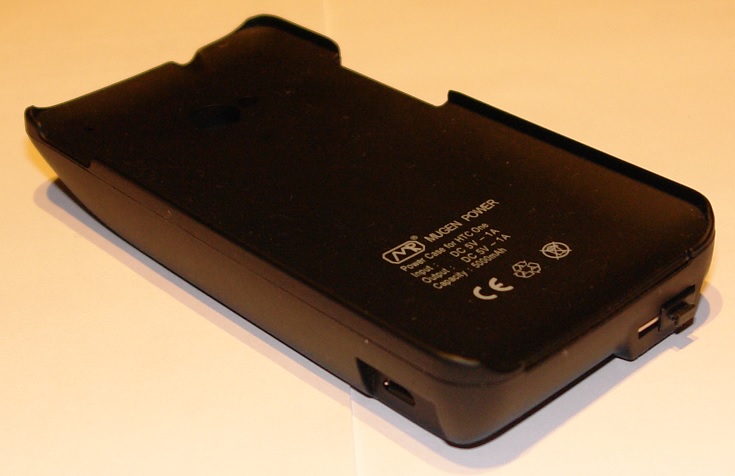
View from the inside
The inner surface is concave, repeating the bend of the back of the smartphone. The sides repeat the contour of HTC One, the back is slightly convex, with a bevel at the top. On the table is stable, not swinging. In the area of the volume button - a cutout in the entire thickness of the cover.
For the camera and flash in the case, large recesses are made. The viewing angle of the camera is not reduced. I will note that for the microphone located on the list of the smartphone (in the upper plastic groove) a corresponding hole has been made in the case.
The case consists of two welded halves. The first one is the inner plate that fits the back of the smartphone, with sides to hold it. The second is everything else. Inside - the battery and power supply.

Case and smartphone
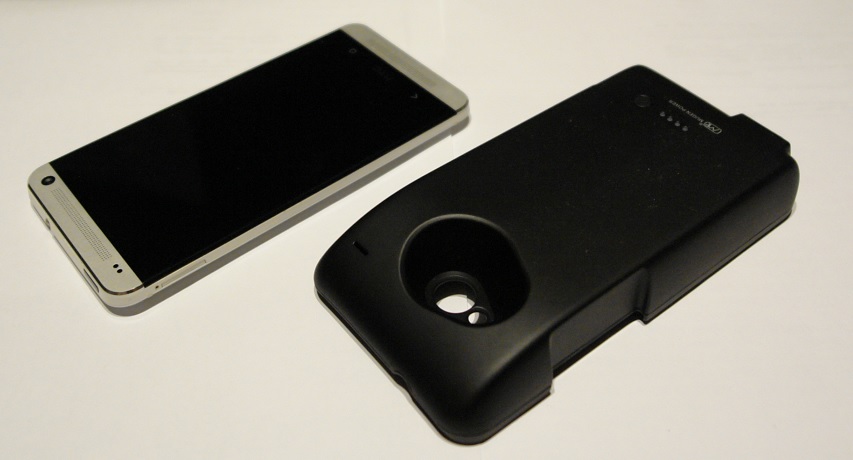
Holes for camera and flash
On the back of the case is a charge indicator. When you press the round button to its right for a couple of seconds, a group of four blue diodes lights up, indicating the charge. One diode - 25 percent. If the charge is less than 10 percent, the rightmost diode will flash. In my opinion, a very useful thing, although taken for granted.
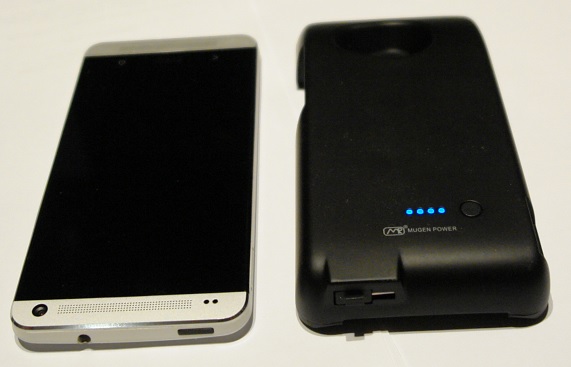
Charge indicator
By my calculations. The case is much larger in size than the battery itself, even with different boards and wiring. The 3600 mAH battery for HTC Sensation takes up a third of its internal volume. However, space is required for other components of the case. If you look into the natural openings on the case, you can see a lot of free internal space.
The smartphone is applied to the inner surface of the cover, fixing due to the friction force of the rim. They cover far from the entire side surface of the smartphone, leaving the volume button, the sim card compartment, most of the upper and lower rims of the device open. As a result, the case does not provide any strongly visible additional protection against falls or strikes, but still protects the four corners. If the device lies on the screen table down, no part of the table cover will touch.
The device keeps tightly enough in the case, it does not spontaneously fall out even if you shake the whole structure, holding it by the case.
To extract the smartphone you have to pick it out for the top or bottom edge.
Pictures of the smartphone installed in the case:
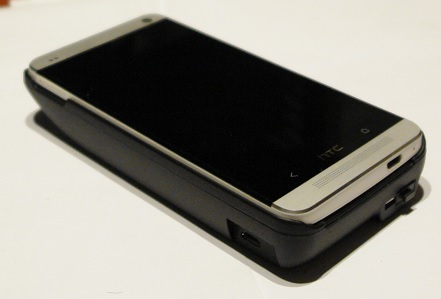



A smartphone installed in the case, from the "shovel" really turns into a brick. The width and height practically do not change, but the thickness of the structure increases several times. And I want to say that I like it. Awesome like it! Manufacturers of top-end devices in pursuit of record thickness forget that the device must somehow be held in their hands (we modestly keep silent about batteries). Thin edges, the tile profile practically do not leave places where you can put your finger. For example, HTC One is beautiful and thin, but its turned metal edges really cut into the palm, especially during a telephone conversation (but this is my personal opinion).
The smartphone in the case also fits perfectly into my fairly large hand, allowing me to firmly hold my fingers. A cutout under the volume button locks the thumb. I feel that I am holding in my hands a thing that is not only powerful, but also with a large supply of autonomous course! The device looks "brutal" and powerful.
Headphone jacks leave room for a headset, even with a very large plug. The volume button is available without difficulty, as before.
Now about the minuses. The power button, and so is not ideally located on the upper edge, also beveled to the user, will now be located next to the side of the case. As a result, you can press it strongly giving a finger or a precise blow of the nail.
The assembly of the cover is good, the hand does not scratch anything. When shaking inside, nothing rattles.
I must say that I was disappointed here. While waiting for the battery, I wondered how the engineers would solve such a delicate and complex issue of connecting the USB port of the smartphone and the battery output. As an example was the Mophie Juice Pack, which adds height to the structure, but reliably hides and fixes the connector. It can be said that the charging element is hidden from prying eyes.
What came up with the engineers Mugen-Power. And they came up with a certain element that I would like to call "pipiska on a string" (the term was invented by Alexei Exler in the review of the smartphone on Windows Mobile 6 Samsung WiTu, but there was a stylus about it). In the case of the cover is hidden L-shaped USB plug, from which stretches a thin spiral wiring. This improvised spring acts as a retainer for the plug in the case, as there are simply no others. The dimensions of the groove slightly exceed the dimensions of the plug, so that it will not work on friction.
The wiring is rigidly connected to the plug, there is no rubber damper at the junction (as is the case, for example, on headphones). There are big fears that he can quickly fray in this place.
Below is a photo of the plug inserted into the smartphone:
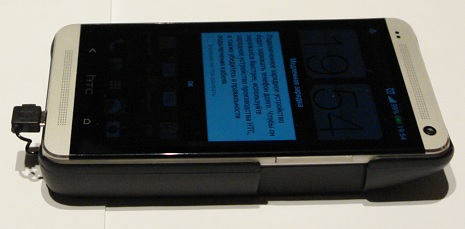

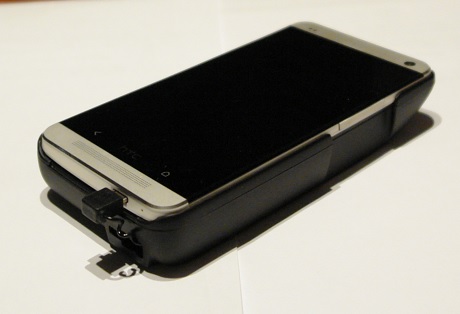
After a week of use, the spring wiring weakened, and the plug began to fall out of its slot in the case. A mini-pen on a plug, designed to remove it from its cover, readily clings to clothing items, with the result that the plug is outside the internal space of the cover.
We now use the plug for its intended purpose. In the connector of the smartphone, he sits very tightly, does not fall out when shaking. But look at the images - such a “scion” still asks to be broken off at the nearest corner or protruding part of clothing. It is enough to touch the installed plug — and instead of two objects (a smartphone and a cover, you will have at least three. I experienced such “fright” on the second day.
In conclusion of this section, I want to say that the connection system chosen by Mugen’s engineers is far from ideal. Low reliability and fragility of the design, which became noticeable after a couple of days of use, the inconvenience when using a smartphone in a case.
Apparently, the desire to reduce the size of the cover and reduce the cost of the whole structure forced the developers to choose this option, while competitors found a more ergonomic option.
The main function of the case with a built-in battery, for which it is possible and even necessary to endure all the difficulties and shortcomings of the design listed above. Unlike the extended battery, installed directly in the smartphone, for the external battery you can explore only two modes6 “charge” and “not charge”, the movie will show and the device will play toys from the internal battery.
The battery capacity in the case is 5000 mAh. In the smartphone - 2300 mAh. The case requires 5V, 1A for charging, theoretically it can give as much.
Fully charging an empty battery with a HTC branded charger on 1A takes about 6 hours. It should be noted that the indicator on the case will show 4 divisions (that is, the full charge) much earlier than this full charge is accumulated. This can be seen on the indicator next to the charging connector. Lit red - charging is in progress, green - charging is over.
It is allowed to charge the case along with the smartphone installed in it.
When you connect the plug to the smartphone, the latter immediately gives a warning that the device will charge very slowly from such a charger. Strange, but what about 1 A in the Output line on the case? Check with Battery Monitor Widget. The cover gives an average of 430 mA , the graph is flat. When the screen is off, the smartphone charges at 20 percent per hour. By the end of charging speed decreases. Total we have about 5 and a half hours for a set of full charge (measured from 3 percent to 100). If you add another half hour for reliability 9-green indicator on the smartphone does not mean a full charge of the smartphone, we get an impressive 6 hours.
Is it a lot or a little? For comparison, reading a book with a brightness set to one-third consumes about 150 mA of current. Under maximum load, the device can “eat” 1.2 A (maximum current that I saw). Thus, when charging, it is better to leave the device to lie with the screen off, and to do it at night.
A full charge of a battery charged with several charge-discharge cycles is, on average, one and a half times the charge of a smartphone , and two full ones are definitely not enough.
When charging the smartphone from the case, the lower edge of the latter is weakly heated, the surface becomes warm. When charging the case itself, heating affects a larger area, heating is larger, but does not burn. The smartphone is practically not heated, low charge current affects.
Wireless interfaces.
The case does not significantly affect the sensitivity of the mobile network module and WiFI.
As a result, the efficiency of the cover can be assessed as low. Of the 5000 mAh charge, the smartphone gets two thirds. It was expected, but I was counting on two full charges, and with greater speed.
At the end of the story of how the "shovel" turned into a "brick" - a few photos of the case with a smartphone in the hands of a very tiny girl.

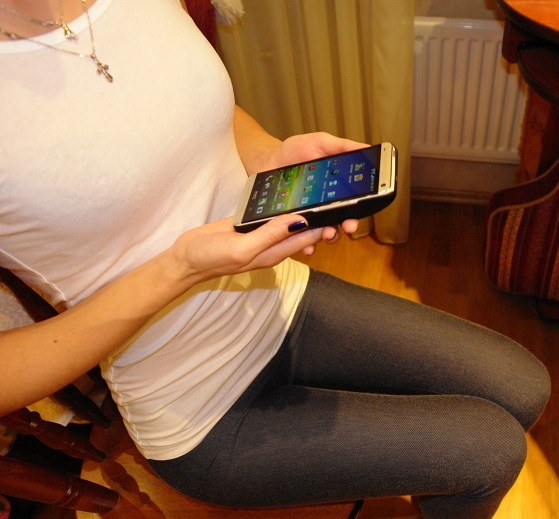

Pros:
- Comfortable shape and pleasant materials
- Width and height only slightly larger than a smartphone
- Ability to charge your smartphone at any time, without limitation in the functions of the device, at least one full time.
Minuses
- The mechanism of connecting the smartphone with the case is very inconvenient and unreliable
- Long time charging
The product has left mixed impressions. On the one hand, I like how the device feels with a large battery. You can afford during the day with might and main to use the smartphone, not thinking about the level of charge. And even if there is no outlet in the evening, in the morning I will still have a fully charged device. And it can again be used intensively.
On the other hand, the charging connector is extremely uncomfortable. When using it, care must be taken so as not to break the entire structure with a careless movement. The wire is thin, a big risk that it will break when used - to insert the plug into the smartphone, you have to make some effort. Yes, and the plug constantly drops out of the groove in the case.
For myself, I decided that such a device is useful to me. Not in everyday life (now at work I poke smartphones at screens more often than at a PC monitor), where a smartphone can be charged from a PC or a power outlet, but on vacation or a long trip out of town. The cost, of course, is high - with delivery will be about 4500 rubles.
Of the competitors can be called Mophie Juice Pack (http://www.mophie.com/shop/smartphones/juice-pack-htc-one) capacity is two times lower, but it looks more convenient, more reliable. And judging by the reviews, it charges faster.
The battery page on the site Mugen-Power, where you can order it:
mugen.co/htc/htc-one.html
As an introduction.
On Habré already have my review of the battery from a reputable company Mugen-Power:
habrahabr.ru/post/139751
As a start, I will tell you a long sad story of getting this device. I received my HTC One on the very first day of sales in Russia, in the St. Petersburg store HTC-Online, HTC's branded sales point. Almost immediately, remembering my positive experience of using batteries from Mugen (I allow myself such diminutive treatment), I wrote to a company representative that I wanted to get an extended battery for my device to test and write a review. The answer was positive, and I waited. And so, batteries for flagships of the first half of 2013 appeared: Samsung S4, Sony Z, Blackberry z10. For HTC, there wasn’t yet - the deadline was set for early summer, June. Then it was transferred to July, they beat the difficulties with the design. And now, at the end of August, the news appeared that the battery will be embodied in iron plastic (and other materials used in lithium-ion batteries) and will go on sale in September. On September 12, I received a tracking number for my gift. But ... The battery did not pass the internal quality control, went for revision in October. And in November, restrictions were imposed on the shipment of batteries by Hong Kong Post. Slal nothing and nothing. In sadness, I started repairing the apartment, wondering if it would be ready faster - my house or a battery. At the end of November, a method of dispatch was found, FedEx Sends quickly and efficiently, but expensive. It turns out, according to colleagues, up to 1,500 rubles. That at the average cost of the battery in the same 1500 wants to buy a very expensive invoice. So, on December 3, the parcel was sent to me.
')
Delivery
Delivery is made by FedEx at the buyer's expense. Delivery from Hong Kong to Moscow and St. Petersburg will cost about 1,500 rubles. After sending the order, the user receives a link to the FedEx website page, where he can look at where his package is now located, when delivery is tentatively completed. Information is updated in real time.

FedEx Parcel Tracking Page
Parcel
The battery comes in a very large sealed FedEx package. It contains a smaller cardboard bag (earlier they were sent to these), and it already contains plastic packaging with a battery.
Battery kit
The package consists of two plastic halves, not connected in any way. Content can be pulled out and put back without spoiling the look of plastic. Not very good, but for Mugen, this tradition. On the other hand, plastic is covered with two sealed bags, so you can, in my opinion, not to worry about the package.
In plastic there is a cardboard that plays the role of a bath lid with a battery with a minimum of information: where to charge, how to check the charge. And that's all. In the past, a large sheet was attached with gratitude for the purchase, information on how to properly charge the first times. I liked it very much, it’s a pity that they have now abandoned the pleasant and useful “bonus” with a penny value.
There is a thin sponge behind the cardboard with the text (polystyrene foam?), And behind it the same thing that I had been waiting for - the battery case!
Charger or cable not included. I did not count on them, but for some reason I think that HTC's 1A brand charger will not be enough to charge such a large battery, especially considering the ability to simultaneously charge a smartphone.
Battery Case
The body is made entirely of soft-touch plastic. I have a copy of black, there is still white. The coating is very, very pleasant to touch, the hand does not slip, there are practically no marks on the surface. Scrabble reluctantly. For a week, nowhere has become shabby, not worn off. I checked it, keeping in mind the cover for the mega-battery for HTC Sensation, where all the soft-touch on the ribs quickly came off, exposing the usual smooth shiny plastic.

View from the outside

View from the inside
The inner surface is concave, repeating the bend of the back of the smartphone. The sides repeat the contour of HTC One, the back is slightly convex, with a bevel at the top. On the table is stable, not swinging. In the area of the volume button - a cutout in the entire thickness of the cover.
For the camera and flash in the case, large recesses are made. The viewing angle of the camera is not reduced. I will note that for the microphone located on the list of the smartphone (in the upper plastic groove) a corresponding hole has been made in the case.
The case consists of two welded halves. The first one is the inner plate that fits the back of the smartphone, with sides to hold it. The second is everything else. Inside - the battery and power supply.

Case and smartphone

Holes for camera and flash
On the back of the case is a charge indicator. When you press the round button to its right for a couple of seconds, a group of four blue diodes lights up, indicating the charge. One diode - 25 percent. If the charge is less than 10 percent, the rightmost diode will flash. In my opinion, a very useful thing, although taken for granted.

Charge indicator
By my calculations. The case is much larger in size than the battery itself, even with different boards and wiring. The 3600 mAH battery for HTC Sensation takes up a third of its internal volume. However, space is required for other components of the case. If you look into the natural openings on the case, you can see a lot of free internal space.
Installing the smartphone in the case
The smartphone is applied to the inner surface of the cover, fixing due to the friction force of the rim. They cover far from the entire side surface of the smartphone, leaving the volume button, the sim card compartment, most of the upper and lower rims of the device open. As a result, the case does not provide any strongly visible additional protection against falls or strikes, but still protects the four corners. If the device lies on the screen table down, no part of the table cover will touch.
The device keeps tightly enough in the case, it does not spontaneously fall out even if you shake the whole structure, holding it by the case.
To extract the smartphone you have to pick it out for the top or bottom edge.
Pictures of the smartphone installed in the case:




The convenience of use
A smartphone installed in the case, from the "shovel" really turns into a brick. The width and height practically do not change, but the thickness of the structure increases several times. And I want to say that I like it. Awesome like it! Manufacturers of top-end devices in pursuit of record thickness forget that the device must somehow be held in their hands (we modestly keep silent about batteries). Thin edges, the tile profile practically do not leave places where you can put your finger. For example, HTC One is beautiful and thin, but its turned metal edges really cut into the palm, especially during a telephone conversation (but this is my personal opinion).
The smartphone in the case also fits perfectly into my fairly large hand, allowing me to firmly hold my fingers. A cutout under the volume button locks the thumb. I feel that I am holding in my hands a thing that is not only powerful, but also with a large supply of autonomous course! The device looks "brutal" and powerful.
Headphone jacks leave room for a headset, even with a very large plug. The volume button is available without difficulty, as before.
Now about the minuses. The power button, and so is not ideally located on the upper edge, also beveled to the user, will now be located next to the side of the case. As a result, you can press it strongly giving a finger or a precise blow of the nail.
The assembly of the cover is good, the hand does not scratch anything. When shaking inside, nothing rattles.
Connecting a smartphone with a battery
I must say that I was disappointed here. While waiting for the battery, I wondered how the engineers would solve such a delicate and complex issue of connecting the USB port of the smartphone and the battery output. As an example was the Mophie Juice Pack, which adds height to the structure, but reliably hides and fixes the connector. It can be said that the charging element is hidden from prying eyes.
What came up with the engineers Mugen-Power. And they came up with a certain element that I would like to call "pipiska on a string" (the term was invented by Alexei Exler in the review of the smartphone on Windows Mobile 6 Samsung WiTu, but there was a stylus about it). In the case of the cover is hidden L-shaped USB plug, from which stretches a thin spiral wiring. This improvised spring acts as a retainer for the plug in the case, as there are simply no others. The dimensions of the groove slightly exceed the dimensions of the plug, so that it will not work on friction.
The wiring is rigidly connected to the plug, there is no rubber damper at the junction (as is the case, for example, on headphones). There are big fears that he can quickly fray in this place.
Below is a photo of the plug inserted into the smartphone:



After a week of use, the spring wiring weakened, and the plug began to fall out of its slot in the case. A mini-pen on a plug, designed to remove it from its cover, readily clings to clothing items, with the result that the plug is outside the internal space of the cover.
We now use the plug for its intended purpose. In the connector of the smartphone, he sits very tightly, does not fall out when shaking. But look at the images - such a “scion” still asks to be broken off at the nearest corner or protruding part of clothing. It is enough to touch the installed plug — and instead of two objects (a smartphone and a cover, you will have at least three. I experienced such “fright” on the second day.
In conclusion of this section, I want to say that the connection system chosen by Mugen’s engineers is far from ideal. Low reliability and fragility of the design, which became noticeable after a couple of days of use, the inconvenience when using a smartphone in a case.
Apparently, the desire to reduce the size of the cover and reduce the cost of the whole structure forced the developers to choose this option, while competitors found a more ergonomic option.
Smartphone charge
The main function of the case with a built-in battery, for which it is possible and even necessary to endure all the difficulties and shortcomings of the design listed above. Unlike the extended battery, installed directly in the smartphone, for the external battery you can explore only two modes6 “charge” and “not charge”, the movie will show and the device will play toys from the internal battery.
The battery capacity in the case is 5000 mAh. In the smartphone - 2300 mAh. The case requires 5V, 1A for charging, theoretically it can give as much.
Fully charging an empty battery with a HTC branded charger on 1A takes about 6 hours. It should be noted that the indicator on the case will show 4 divisions (that is, the full charge) much earlier than this full charge is accumulated. This can be seen on the indicator next to the charging connector. Lit red - charging is in progress, green - charging is over.
It is allowed to charge the case along with the smartphone installed in it.
When you connect the plug to the smartphone, the latter immediately gives a warning that the device will charge very slowly from such a charger. Strange, but what about 1 A in the Output line on the case? Check with Battery Monitor Widget. The cover gives an average of 430 mA , the graph is flat. When the screen is off, the smartphone charges at 20 percent per hour. By the end of charging speed decreases. Total we have about 5 and a half hours for a set of full charge (measured from 3 percent to 100). If you add another half hour for reliability 9-green indicator on the smartphone does not mean a full charge of the smartphone, we get an impressive 6 hours.
Is it a lot or a little? For comparison, reading a book with a brightness set to one-third consumes about 150 mA of current. Under maximum load, the device can “eat” 1.2 A (maximum current that I saw). Thus, when charging, it is better to leave the device to lie with the screen off, and to do it at night.
A full charge of a battery charged with several charge-discharge cycles is, on average, one and a half times the charge of a smartphone , and two full ones are definitely not enough.
When charging the smartphone from the case, the lower edge of the latter is weakly heated, the surface becomes warm. When charging the case itself, heating affects a larger area, heating is larger, but does not burn. The smartphone is practically not heated, low charge current affects.
Wireless interfaces.
The case does not significantly affect the sensitivity of the mobile network module and WiFI.
As a result, the efficiency of the cover can be assessed as low. Of the 5000 mAh charge, the smartphone gets two thirds. It was expected, but I was counting on two full charges, and with greater speed.
Construction in reality.
At the end of the story of how the "shovel" turned into a "brick" - a few photos of the case with a smartphone in the hands of a very tiny girl.



Total
Pros:
- Comfortable shape and pleasant materials
- Width and height only slightly larger than a smartphone
- Ability to charge your smartphone at any time, without limitation in the functions of the device, at least one full time.
Minuses
- The mechanism of connecting the smartphone with the case is very inconvenient and unreliable
- Long time charging
The product has left mixed impressions. On the one hand, I like how the device feels with a large battery. You can afford during the day with might and main to use the smartphone, not thinking about the level of charge. And even if there is no outlet in the evening, in the morning I will still have a fully charged device. And it can again be used intensively.
On the other hand, the charging connector is extremely uncomfortable. When using it, care must be taken so as not to break the entire structure with a careless movement. The wire is thin, a big risk that it will break when used - to insert the plug into the smartphone, you have to make some effort. Yes, and the plug constantly drops out of the groove in the case.
For myself, I decided that such a device is useful to me. Not in everyday life (now at work I poke smartphones at screens more often than at a PC monitor), where a smartphone can be charged from a PC or a power outlet, but on vacation or a long trip out of town. The cost, of course, is high - with delivery will be about 4500 rubles.
Of the competitors can be called Mophie Juice Pack (http://www.mophie.com/shop/smartphones/juice-pack-htc-one) capacity is two times lower, but it looks more convenient, more reliable. And judging by the reviews, it charges faster.
The battery page on the site Mugen-Power, where you can order it:
mugen.co/htc/htc-one.html
Source: https://habr.com/ru/post/206408/
All Articles